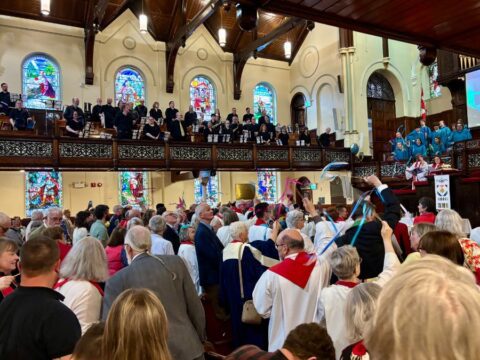Rev. Phyllis Dietrich is the minister of five rural congregations. But on Sunday mornings, she doesn’t race from pulpit to pulpit like a modern-day circuit rider with a sermon in her saddlebag. Instead, she preaches at two of the churches while lay leaders handle the rest.
The arrangement — still an experiment — is called a community co-operative. It’s a new way of helping struggling rural congregations stay viable rather than being forced to close, amalgamate or form larger regional churches. And in small towns, where the church is often the only institution remaining, an open building also means keeping family memories and community history alive.
Dietrich’s churches, part of the Genesis Cooperative Community, are located in eastern Ontario between the Ottawa and St. Lawrence rivers. Settled by United Empire Loyalists and dyed-in-the-wool Québécois, the region now boasts a bilingual majority after generations of intermarriage. The economy has a strong agricultural base, but the farmers are fewer and the acreages larger. Still, the area’s riverside scenery and location — within easy travelling distance to Ottawa and Montreal — attracts both commuters and retirees.
The dilemma that led to the Genesis co-op is a familiar one: fewer and older members, less interest in Sunday worship and more financial pressures. Like many rural churches, the congregations increasingly hired part-time ministers and retired clergy to ease budget pressures. As requests for financial help increased, the Seaway Valley Presbytery formed a vision and transformation committee. Congregations were primed for change with rallies, discussions and consultants’ visits, but initially not much happened.
Then about five years ago, four neighbouring pastoral charges with six congregations found themselves without ordered ministers or budgets to attract them on their own. With encouragement from Presbytery, they began to talk.
One of the churches, Trinity United, is in Vankleek Hill, a town that calls itself the gingerbread capital of Ontario for the ornate wooden trim on many of its buildings. On a Sunday morning at 9:30 a.m. in late spring, a few dozen worshippers trickle into the bright sanctuary. Though the sign outside lists Dietrich as the minister, Margaret MacMillan, a licensed lay worship leader, is conducting today’s service.
A few hours later and eight kilometres away, Cassburn United in L’Orignal, Ont., is meeting in a red-brick building surrounded by well-trimmed lawns, a large community cemetery, a restored rural schoolhouse and fields. Many of the congregation’s members are dairy farmers, so a noon-hour service means they can finish chores and then attend worship.
Today’s service is led by Dietrich, who also presided earlier at nearby Hawkesbury United. MacMillan went on to Kirk Hill United in Dalkeith after the Trinity United service. And lay leader Sandra Osadchuk preached for the Riceville-Pendleton charge (whose congregations worship together and alternate buildings).
Creating the Genesis Cooperative Community was neither quick nor easy, says lay leader Tammy Oswick-Kearney. “There was a lot of shouting” during some meetings. Old wounds had to be healed and fractious relationships in pastoral charges mended. But at one gathering, she says, “something changed . . . and we just went forward from that day.” She says everyone in the room felt the shift. Dietrich sees it as a Pentecost-like blessing. The congregations voted 96 percent in favour.
Two years into the co-operative’s Presbytery-approved three-year experiment, its minister and lay leaders are keeping busy. Presbyteries decide what training is needed for lay leaders and organize the courses. According to United Church guidelines, licensed lay worship leaders are not ministry personnel and can only be paid an honorarium. In Seaway Valley Presbytery, that’s $120 for one service and $25 more for a second service, plus mileage. There are 25 licensed lay preachers in the Presbytery (including the four at Genesis), and more are in training.
The United Church policy also states that licensed lay worship leaders must be members of a local congregation and have “gifts and a sense of call to a ministry of worship leadership and preaching.” But as Oswick-Kearney says, they’re not trying to replace ordered ministers. “We already have jobs. We just want to work with a minister.”
Even with Presbytery’s help, finding the right minister for Genesis wasn’t easy. Some candidates told the co-operative what changes they would make and how they would take charge. Dietrich, on the other hand, understood what the lay people were hoping to accomplish. “We’re trying to make less work for the minister, not more,” says Oswick-Kearney. Recently, when a course on creating a pastoral care team was offered in Ottawa, each co-op congregation was required to send at least two people.
Dietrich says the collaboration between lay people and ministry personnel at Genesis is what she’s been seeking for almost three decades. “They’re on to what I’ve been harping on my whole ministerial career.” She also loves having four enthusiastic colleagues in ministry. “Some of us have forgotten the call to ministry,” she says of her fellow clergy. Hers has been refreshed.
Not everyone in Seaway Valley Presbytery agrees that the cluster model of joining rural churches together (of which the co-operative is the most successful example) is better than a regional church model where small congregations give up local identity and buildings to form a new ministry serving a wider area.
The regional model, with one building, worship service and congregation, is easier for volunteers and less complicated for a minister. Clusters, on the other hand, leave buildings and congregations in place but alter worship patterns and juggle personnel.
But so far, the co-op approach has kept six rural church buildings open for worship and community events. It has also brought the communities it serves much closer together. Each church hosts at least one joint worship service every year. Normally, the minister and two of the lay worship leaders handle Sunday services, no more than two apiece, with geographically close locations paired together.
Churchgoers say they love the variety of preaching styles and appreciate the common bulletins. They can visit another church in the group and feel right at home. Member churches also take part in a joint annual outreach-related project: for the past two summers, they’ve collected canned goods for the local food bank.
The co-operative’s office is a neutral rented space in a medical building in Vankleek Hill, not in any of the churches. A part-time secretary handles administrative tasks and schedules preachers. Each church takes responsibility for its own building maintenance and equally shares one-fifth of all common costs: the minister’s and secretary’s salaries and benefits, office rent and lay leader honoraria.
Congregational structures are simplified too, with a small executive council in each church handling worship and finances. Kelley Allen, who chairs the council at Cassburn United, says work gets done, but the new structure “cuts out a lot of duplication and meetings.”
The good news about the Genesis co-op is spreading beyond Seaway Valley Presbytery. Dietrich has spoken about it by phone with a group in Manitoba’s Selkirk Presbytery that is looking into different ways of delivering rural ministry. She has also visited a pair of pastoral charges in southern Ontario that are beginning to meet and work together.
Marvin Anderson, a rural ministry consultant who is working as part-time interim minister at the three-point Port Rowan (Ont.) pastoral charge, and Ted Smith, designated lay minister on the neighbouring three-point South West Norfolk charge, hosted Dietrich last spring for a series of workshops.
Anderson, who leads Alive and Kicking rural ministry workshops and is part of the EDGE ministry development network, says that “the old pastoral charge formula is not working anymore.” Hearing about Genesis helped his congregants move on from fear and denial about their current situation, he says. A half-dozen people from the two charges are now looking into licensed lay worship leadership courses.
Also, something sounding like Genesis but called a “regional team model” was outlined in a report at the 2012 General Council. Lay ministries, it said, “are meant to function in relationship to ordered ministries, not in a subordinate way, but in a manner that values different gifts and training.” Lay worship leaders are named as a “critical component” of the model. The Executive of General Council voted last fall to encourage regional team ministry and identify any structural roadblocks.
Oswick-Kearney is happy that people want to duplicate the Genesis Cooperative Community’s success, but warns, “Our model won’t work for everybody else. Something similar might work for somebody else, but they will have to do the work too. It’s all about recognizing [your congregation’s situation], being honest and taking a leap.”
As for Genesis, it comes up for review next year and may be forced to fit its co-operative organizational structure into a traditional pastoral charge box. Some churches could drop out or others could ask to join.
One way or another, says Dietrich, “If we ever do go down, it won’t be with a whimper.” Rural and small-town churches, while often financially fragile, can be a formidable force when joined together. As lay leader Sandra Osadchuk says, “We’re still in a lifeboat, but at least we are casting our nets on all sides.”
***
This story first appeared in The United Church Observer’s September 2013 issue with the title “Saving the village churches.”














